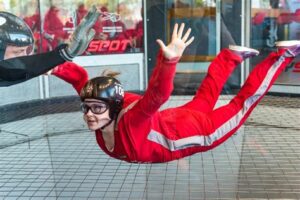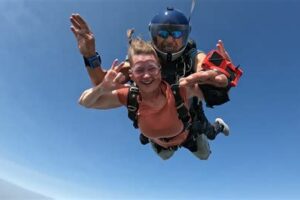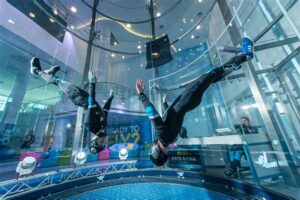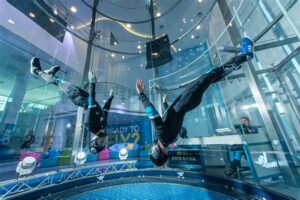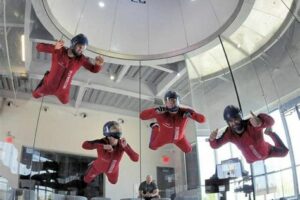Table of Contents
Looking to start an indoor skydiving business? Learn about the costs involved to bring this thrilling experience to your customers. From building and equipment expenses to insurance and training, discover the financial aspects of running an indoor skydiving venture. Determine the investment required and plan your budget accordingly to ensure a successful and profitable business.
Are you considering starting your own indoor skydiving business but are unsure about the costs involved? Look no further! In this article, we will take a comprehensive look at the expenses associated with setting up and running an indoor skydiving facility. Whether you are an adrenaline junkie looking to turn your passion into a profitable venture or an entrepreneur seeking a unique business opportunity, understanding the financial aspects is crucial before taking the plunge. So, let’s dive in and explore the fascinating world of indoor skydiving business costs.
Introduction
Indoor skydiving is an exhilarating experience that allows individuals to simulate the sensation of freefalling through the air without actually jumping out of an airplane. This unique activity has gained popularity in recent years, attracting thrill-seekers and adventure enthusiasts from all walks of life. If you are considering starting an indoor skydiving business, it is crucial to understand the associated costs and financial considerations involved. In this article, we will explore the various expenses you can expect to encounter when setting up and running an indoor skydiving facility.
Facility Acquisition and Construction
The first major cost to consider when starting an indoor skydiving business is acquiring or constructing a suitable facility. You can choose to lease an existing building or construct a new one specifically designed for indoor skydiving. The facility should have enough space to accommodate the wind tunnel, viewing areas, briefing rooms, and other necessary amenities. Depending on the location and size of the facility, this expense can range from several hundred thousand dollars to several million.
Wind Tunnel Installation
The centerpiece of every indoor skydiving facility is the wind tunnel. This vertical wind tunnel generates a powerful updraft, allowing participants to experience the sensation of flying. The cost of a wind tunnel can vary significantly depending on its size, technology, and manufacturer. On average, a state-of-the-art wind tunnel can cost anywhere from $3 million to $10 million. It is essential to choose a reputable supplier and ensure proper installation to guarantee the safety and functionality of the tunnel.
Equipment and Safety Gear
Operating an indoor skydiving business requires a range of equipment and safety gear. This includes flight suits, helmets, goggles, earplugs, and other protective gear for both participants and instructors. Additionally, you will need training props, such as mannequins or dummies, to simulate real skydiving scenarios during instructional sessions. Depending on the size of your facility and the number of participants you anticipate, the cost of equipment and safety gear can range from $50,000 to $100,000 or more.
Staffing and Training
To ensure the smooth operation of your indoor skydiving business, you will need a dedicated team of trained professionals. This includes instructors, customer service representatives, maintenance personnel, and administrative staff. Hiring experienced individuals with a background in skydiving or wind tunnel operations is crucial. Additionally, you may need to invest in training programs and certifications for your employees to enhance their skills and ensure the safety of participants. The cost of staffing and training will depend on the size of your team and their level of expertise.
Marketing and Advertising
Like any business, promoting your indoor skydiving facility is essential to attract customers. Marketing and advertising costs can vary depending on your target market and the reach you want to achieve. Traditional marketing methods such as print ads, billboards, and radio spots can be effective, but investing in online advertising, social media campaigns, and search engine optimization can yield better results in today’s digital age. Allocating a budget for marketing expenses is crucial to create awareness and drive customer engagement.
Insurance and Liabilities
Operating an indoor skydiving business comes with inherent risks and liabilities. It is essential to secure comprehensive insurance coverage to protect your business, employees, and customers against accidents, injuries, and property damage. The cost of insurance will depend on various factors such as the size of your facility, the number of participants, and the coverage limits you choose. Working with an experienced insurance provider who understands the unique risks associated with indoor skydiving is vital.
Operational Expenses
Running an indoor skydiving business involves several ongoing operational expenses. These include rent or mortgage payments for the facility, utilities (electricity, water, heating, etc.), maintenance and repairs, cleaning services, and administrative costs. It is crucial to create a detailed budget that accounts for these recurring expenses to ensure the financial stability and sustainability of your business.
Licensing and Permits
Before opening your indoor skydiving facility, you will need to obtain the necessary licenses and permits from local authorities. The requirements may vary depending on your location and jurisdiction, but typically include permits for construction, zoning compliance, health and safety, and business operation. Hiring a legal professional familiar with the specific regulations in your area can help navigate the licensing process efficiently.
Contingency Fund
While careful planning and budgeting can help minimize unexpected expenses, it is always wise to have a contingency fund in place. Unforeseen circumstances such as equipment breakdowns, legal disputes, or economic downturns can impact your business’s financial stability. Setting aside a portion of your initial investment as a contingency fund can provide a safety net and help you navigate any unforeseen challenges that may arise.
Conclusion
Starting an indoor skydiving business requires a significant upfront investment, but with careful planning and consideration of the various costs involved, it can be a profitable venture. Understanding the expenses associated with facility acquisition, wind tunnel installation, equipment and safety gear, staffing, marketing, insurance, operational expenses, licensing, and permits is crucial for long-term success. By allocating resources wisely and providing a safe and thrilling experience for your customers, an indoor skydiving business can soar to new heights in the adventure tourism industry.
Indoor Skydiving Business Cost: Planning for Success
When embarking on the journey of starting an indoor skydiving business, careful planning and budgeting are essential for long-term success. Understanding the various costs involved in setting up and operating such a venture is crucial to ensure a smooth and profitable operation. In this article, we will explore the key components of indoor skydiving business cost and provide insights into how to plan effectively.
1. Facility Expenses:
One of the primary expenses when establishing an indoor skydiving business is the facility itself. Finding a suitable building that can accommodate the required infrastructure is vital. The size and location of the facility should be carefully considered to ensure it meets safety requirements and provides an enjoyable experience for customers. Costs may include acquiring or leasing the space, renovating it to meet safety standards, and installing specialized wind tunnel equipment. Proper planning and budgeting for facility expenses will set the foundation for a successful operation.
2. Equipment Costs:
Investing in high-quality wind tunnel equipment is a significant part of the indoor skydiving business cost. This includes purchasing the vertical wind tunnel, control systems, and safety measures such as netting and padding. It is important to allocate funds not only for the initial purchase but also for ongoing maintenance, repairs, and upgrades to ensure the equipment remains in optimal condition. Prioritizing the quality and reliability of the equipment is crucial for both safety and customer satisfaction.
3. Staffing Expenses:
A well-trained and knowledgeable team is essential for running an indoor skydiving business successfully. Staffing expenses include hiring skilled instructors, operational personnel, and administrative staff. Additionally, training programs and certifications should be factored into the budget to ensure compliance with industry standards. Properly compensating and retaining qualified staff is crucial for providing a safe and enjoyable experience for customers. Allocating the necessary resources for staffing expenses will contribute to the overall success of the business.
4. Licensing and Permits:
Complying with legal and regulatory requirements is vital for any business, and an indoor skydiving facility is no exception. Obtaining the necessary licenses and permits, such as building permits, zoning permits, safety certifications, and insurance coverage, is an essential part of the cost structure. Researching and understanding the specific requirements in your location will help avoid potential delays and fines that can impact both the timeline and budget of the business.
5. Marketing and Advertising:
To attract customers and establish a strong brand presence, allocating a portion of the budget for marketing and advertising is crucial. Creating a visually appealing website, implementing online marketing strategies, distributing promotional materials, and potentially investing in traditional advertising platforms are all important aspects of marketing an indoor skydiving business. A well-executed marketing plan plays a significant role in growing the customer base and generating revenue.
6. Insurance Coverage:
Insurance costs form a critical part of the overall expenditure for an indoor skydiving business. Due to the nature of the activity, comprehensive liability coverage is essential to protect both the business and its customers. Additionally, property insurance and worker’s compensation coverage are necessary to safeguard against unforeseen events. Consulting with experienced insurance professionals will ensure that adequate coverage is obtained, providing peace of mind for both the business owner and the customers.
7. Utilities and Maintenance:
Operating an indoor skydiving facility incurs ongoing expenses for utilities such as electricity, heating, and air conditioning. Wind tunnels require substantial energy to function, so factoring in these costs is crucial. Regular maintenance and servicing of the wind tunnel equipment, HVAC systems, and general upkeep of the facility should also be considered to ensure a safe and enjoyable experience for customers. Properly planning for utilities and maintenance expenses will contribute to the long-term success of the business.
8. Miscellaneous Expenses:
Unforeseen expenses can arise in any business, and having a contingency budget is essential. Accounting for miscellaneous costs such as legal fees, accounting services, technology upgrades, software licenses, and security measures is important. Having a buffer in the budget allows for flexibility in dealing with unexpected situations while minimizing potential disruptions to day-to-day operations. Properly planning for miscellaneous expenses will ensure the smooth operation of the indoor skydiving business.
In conclusion, planning for the various costs involved in setting up and operating an indoor skydiving business is crucial for long-term success. Understanding the expenses related to facility setup, equipment purchase and maintenance, staffing, licensing and permits, marketing, insurance coverage, utilities and maintenance, and miscellaneous expenses will enable business owners to allocate resources effectively and ensure a profitable venture. By prioritizing these aspects and budgeting accordingly, indoor skydiving businesses can thrive and provide an unparalleled experience for their customers.
Indoor skydiving has become an increasingly popular recreational activity in recent years, attracting thrill-seekers and adventure enthusiasts from all walks of life. For entrepreneurs looking to capitalize on this growing trend, starting an indoor skydiving business can be a lucrative venture. However, it is crucial to carefully consider the costs associated with such a venture before diving in.
When it comes to establishing an indoor skydiving business, there are several key expenses that need to be taken into account:
- Facility: The primary cost involved in setting up an indoor skydiving business is acquiring or leasing a suitable facility. This includes finding a large enough space that can accommodate the necessary vertical wind tunnel and related infrastructure. The cost will vary depending on factors such as location, size, and condition of the property.
- Equipment: Investing in state-of-the-art wind tunnel technology is essential for providing a safe and enjoyable experience for customers. This includes purchasing or leasing the wind tunnel itself, as well as the necessary safety gear such as flight suits, helmets, and goggles. The cost of equipment can be significant but is crucial for ensuring the highest level of customer satisfaction and safety.
- Staffing: Running an indoor skydiving business requires a team of skilled and qualified instructors who can guide customers through their flight experiences. Hiring and training experienced instructors is essential for maintaining the reputation and credibility of the business. Additionally, administrative staff may be required to handle customer inquiries, bookings, and other operational tasks.
- Marketing and Advertising: Promoting the business and attracting a steady stream of customers is crucial for its success. Allocating a budget for marketing and advertising activities is necessary to create brand awareness and reach the target audience effectively. This may include online advertising, social media campaigns, print media, and partnerships with local tourism agencies.
- Insurance and Legal Fees: As with any business, it is vital to have appropriate insurance coverage to protect against potential liabilities. This includes liability insurance for customers and employees, as well as property insurance for the facility and equipment. Additionally, legal fees may be incurred when setting up the business, obtaining necessary permits and licenses, and ensuring compliance with local regulations.
It is important to note that the costs mentioned above are just some of the key expenses associated with starting and running an indoor skydiving business. Other factors to consider include ongoing maintenance and repair costs, utility expenses, and taxes.
In conclusion, while the initial investment required for establishing an indoor skydiving business can be substantial, the potential for profitability and success is significant. However, it is crucial to conduct thorough research, create a comprehensive business plan, and carefully manage expenses to ensure the long-term viability of the venture.
Dear blog visitors,
Thank you for taking the time to visit our blog and learn more about the cost of starting an indoor skydiving business. We understand that this can be an exciting and potentially lucrative venture, and we are here to provide you with valuable information to help you make informed decisions.
Starting any business requires careful consideration of various factors, and an indoor skydiving business is no exception. One of the primary concerns for aspiring entrepreneurs is the cost involved in setting up such a facility. It is crucial to have a clear understanding of the expenses you will incur so that you can plan your finances accordingly.
Firstly, let’s discuss the initial investment required to establish an indoor skydiving business. The cost can vary depending on various factors such as location, size of the facility, and the equipment you choose to install. On average, you can expect to spend anywhere between $2 million to $5 million for a basic setup. This includes the construction of a wind tunnel, ventilation systems, safety measures, and necessary training facilities. Keep in mind that these figures are estimates, and the actual cost may differ based on individual circumstances.
Secondly, it is essential to consider the recurring expenses involved in running an indoor skydiving business. These include employee salaries, maintenance costs, utilities, insurance, marketing, and ongoing training programs. It is recommended to have a detailed financial plan that takes into account these costs to ensure the smooth operation of your business. Transitioning from the initial investment phase to the day-to-day management phase requires careful budgeting and financial discipline.
Lastly, it is worth mentioning that financing options are available for those who may not have the entire investment amount readily available. You can explore commercial loans, partnerships, or even seek investors who are interested in supporting your venture. However, it is crucial to have a solid business plan and financial projections to attract potential investors or secure loans from financial institutions.
In conclusion, starting an indoor skydiving business can be an exciting and rewarding endeavor. However, it is essential to have a realistic understanding of the costs involved and to plan accordingly. We hope that the information provided in this article has given you valuable insights into the expenses associated with this business. If you have any further questions or require additional guidance, please feel free to reach out to us. We wish you all the best in your entrepreneurial journey!
Sincerely,
The Indoor Skydiving Business Team
Video Indoor Skydiving Business Cost
People also ask about Indoor Skydiving Business Cost:
1. How much does it cost to start an indoor skydiving business?
Starting an indoor skydiving business can be quite expensive. The cost primarily depends on various factors such as the location, size of the facility, equipment, and marketing expenses. On average, the initial investment can range from $1 million to $5 million.
2. What are the ongoing costs of running an indoor skydiving business?
Running an indoor skydiving business involves ongoing costs that need to be considered. These costs typically include rent or mortgage payments for the facility, utilities, insurance, maintenance and repairs, staff salaries, marketing expenses, and equipment maintenance. The exact amount will vary based on the size of the facility and the number of customers served.
3. Are there any additional costs associated with an indoor skydiving business?
Yes, there may be additional costs associated with an indoor skydiving business. These can include licensing fees, permits, legal fees, taxes, training and certification costs for instructors, website development and maintenance, and advertising expenses. It is important to thoroughly research and consider all potential costs before starting the business.
4. How long does it take for an indoor skydiving business to become profitable?
The time it takes for an indoor skydiving business to become profitable can vary depending on several factors, such as location, marketing efforts, competition, and customer demand. Generally, it may take a few years to start generating consistent profits. However, with proper planning, effective marketing strategies, and providing exceptional customer experiences, profitability can be achieved within a reasonable timeframe.
5. Are there financing options available for starting an indoor skydiving business?
Yes, there are various financing options available for starting an indoor skydiving business. These can include traditional bank loans, Small Business Administration (SBA) loans, private investors, crowdfunding, and partnerships. It is advisable to consult with financial experts and explore different options to determine the best financing solution for your specific business needs.
Overall, starting and running an indoor skydiving business requires a significant investment of time, money, and resources. It is essential to conduct thorough market research, create a solid business plan, and seek professional advice to ensure the success and profitability of your venture.

